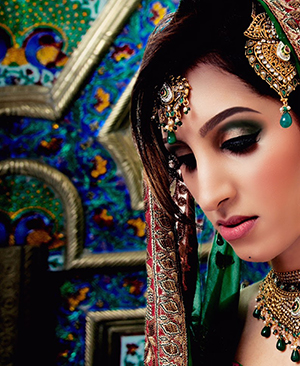Guide to Indian Jewellery
This guide to Indian Jewellery is based on our years of experience in the Indian jewellery industry & is designed to assist you, our client.
For your ease of use, we have linked this guide to the relevant sections of our website so that you can see pictures of the Indian Jewellery we are describing here.Indian Jewellery for the Neck
• Choker: this is a necklace worn tightly around the neck, we recommend these for clients with normal to long necks. Choker necklaces will continue to trend in Indian Fashion for 2025 but will now incorporate large gems and heavy beading.
• Pendant set: a pendant on a necklace chain. Our fine American diamond pendant & earring sets can be worn with a real gold/silver chain.
• Collar necklace: this is a necklace that sits at the base of the neck & lower. Sabyasachi Mukherji, the prolific Mumbai fashion designer, popularised collar necklaces which cover the whole of the chest area for his Indian bridal clients. Collar necklace sets can vary greatly in size depending upon the Asian occasion.
• Rani haar: this Indian necklace is a large decorated pendant permanently attached to a long chain. The pendant part should sit on the bust or lower. This is often worn with another necklace usually a collar necklace (but it is personal preference how this is worn). Rani haars are a traditional type of Indian necklace. Rani haars are well suited to taller ladies who or those who wear a hijab.
Indian Jewellery for Ears
• Jhumka: Indian earrings with hanging bell-shaped decoration.
• Tops: these are large decorated stud earrings & will continue to be the height of fashion in 2025.
• Sahara chain: Indian accessory to any Indian Earring. Traditionally this was used to support the vast weight of heavy 22K gold earrings. A Sahara is a chain going from the front of the earring over the ear & either: hooked directly into the hair; or around the back of the ear. It can be affixed using loops which you feed onto the earring post.
Indian Jewellery for the Head & Hair
• Matha Patti: a decorated chain that is worn along the hair-line. A matha-patti is always worn with an attached central maang tikka. Matha-pattis originate from south India. However, this traditional hair ornament is very much in Vogue for all Asians in recent years - for both brides (when worn with a full bridal necklace set) and for guests (if worn with no/just earrings).
• Jhumar / Passa: this is a traditional Pakistani head ornament. IT is clipped into the hair and is worn over the temple (usually left side). This has become increasingly fashionable in recent years and is now worn across India.
• Hair Chotli: this is a long elaborate chain that you pin onto the outside of a plait. This has been very much in fashion
Indian Jewellery for Hands & Arms
• Cocktail Rings: a large ring, can be worn instead of hath panjas for a modern & fashionable bridal look.
• Bajuband: this is a decorated chain worn around the upper arm i.e. an armlet.
• Indian Bangles: these come in 2 main types: Kangans & Churis.
Kangans are wider in design and can be worn alone or more classically on the 2 outer edges of a bangle set, to frame it. Most of our kangans have a screw fastening so 1 size can fit many, please check individual product descriptions.
Churis are thinner in design as many of these are worn at a time, with kangans
The Indian sizing numbers represent the diameter of the bangle in inches & fractional inches, so 2.6 means a bangle diameter of 2 6/16 inches. This diameter could represent the inner or outer points of the bangle.
Indian Jewellery for the Nose
These can be attached in 3 ways:
o Clip-on
o Screw on
o Earring style: suitable for pierced noses only.
A nath can come with or without a long chain that is draped along the cheek and then hooked into the hair. The most common style is with a chain - the chain also adds support to naths for noses that are not pierced.
Indian Jewellery for Feet
• Toe rings: Worn by all. We recommend Indian toe rings for brides on their mendhi night, as your feet will be on display but you cannot wear an anklet as it will probably interfere with your mendhi application.
Indian Jewellery for Sarees
• Saree Clip: Traditionally used as a keychain by the lady of the haweli, but now used as a fashion accessory.
• Indian brooches: can be worn on a chuni, saree or head scarf.
Our top fashion tip: Use a heavy Indian brooch at the end of a saree pallu to weigh it down & make it hang better… looks pretty too!
Indian Bridal Jewellery
Our Closing Comments
Indian Jewellery Store Team. x

